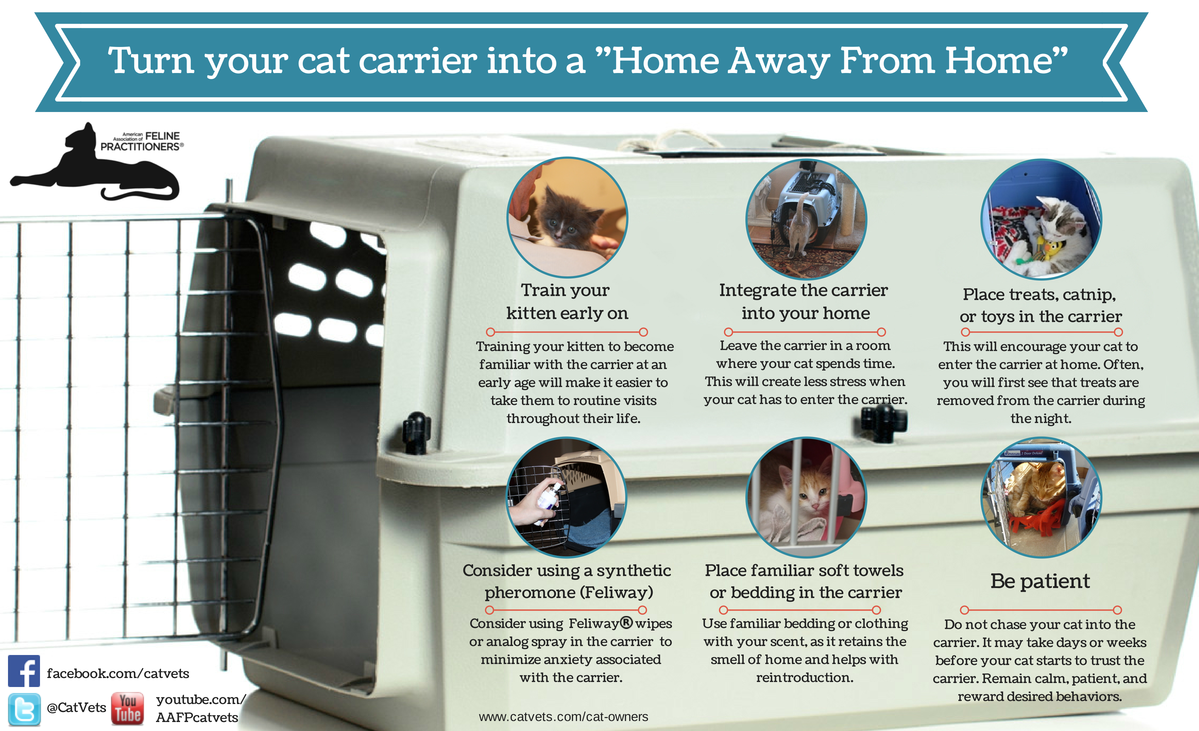Routine yearly healthy pet examinations are part of good health care and can allow your cats to have longer, more
comfortable lives. But, many cats dislike coming to the clinic; I would even say most. My cat "Mango" for instance loathes the trip in - no snacks, no litter box, poorly responsive attendants when he inevitably needs to use the non-existent litter box. The challenge starts with getting cats in the carrier and getting them to the clinic. If we make that step easier, everything improves. The following information is reprinted from the American Association of Feline Practitioners (AAFP) website. They are an ongoing wealth of kitty information.
- Cats are most comfortable with the familiar, and need time to adjust to the unfamiliar. The visit to the veterinarian is often difficult because the carrier, car, and the veterinary hospital are unfamiliar. Your cat will need time to become familiar with new situations, people and places.
- Stay calm. Cats can sense our anxiety and frustrations, and this may cause them to become fearful or anxious.
- Cats do not learn from punishment or force. Give rewards to encourage positive behavior. Try to find treats that your cat thinks are delicious and are motivating. If your cat is sitting calmly in or near a carrier, give a treat. Likewise, rewards can be given to help your cat become familiar with types of handling that may happen at the clinic. Play or affection may also be seen as rewards.
- The goal is for your cat to learn to associate the carrier with positive experiences and routinely enter voluntarily.
- Make the carrier a familiar place at home by leaving it in a room where your cat spends lots of time.
- Place familiar soft bedding inside the carrier. Bedding or clothing with your scent can make them feel more secure.
- Place treats, catnip or toys inside the carrier to encourage the cat to enter the carrier. At first, you may see the treats removed from the carrier at night.
- It may take days or weeks before your cat starts to trust the carrier. Remain calm, patient and reward desired behaviors.
- If you still have trouble, you may need to assess the carrier itself.
- If your cat needs to go to the veterinarian right away, and is not yet accustomed to the carrier:
- Start by putting the carrier in a small room with few hiding places. Bring the cat into the room and close the door. Move slowly and calmly. Do not chase the cat to get it into the carrier. Encourage the cat with treats or toys to walk into the carrier.
- If your cat will not walk into the carrier, and your carrier has an opening on the top, gently cradle your cat and lower it into the carrier.
- Another option is to remove the top half of your carrier while getting the cat to go into the bottom half, and then calmly replace the top.
- Consider use of synthetic feline facial pheromone (Feliway®) analog spray in the carrier at least 30 minutes prior to transport to help calm the cat.
Coming Home – Cats are very
sensitive to smells, and unfamiliar smells can result in one cat no longer
recognizing another. Aggressive behavior
can occur when one cat senses another as a stranger. Consider the following.
- Leave the returning cat in the carrier for a few minutes to see how all of your cats react.
- If all cats appear calm and peaceful, let the returning cat out of the carrier.
- If you sense tension between the cats, or if previous home-comings have resulted in conflict, keep the cat in the carrier and take it to a separate room to avoid potential injury from an upset cat. Provide food, water and litter box for a minimum of 24 hours while it regains the more familiar smell of home.
- If there is still stress after this time, contact the clinic to discuss slower introduction or medication.
- Feliway can help provide the sense of familiarity.
- For future visits: Use familiar bedding or clothing with your scent, as it retains the smell of home and helps with reintroduction. Use Feliway. Consider bringing both cats to the clinic together. This can prevent future conflict because both cats will carry the scent of the clinic.
The
best carriers are inexpensive hard-sided carriers that open from the top and
the front, and can also be taken apart in the middle. An easily removable top allows a cat which is
fearful, anxious or in pain to stay in the bottom half of the carrier for
exams. We can often do
the exam in the bottom of a well-designed carrier. Avoid
carriers that require a cat to be pulled from or dumped out for an exam. Choose
carriers that are sturdy, secure and stable for the cat, as well as easy for
you to carry. Some cats like to see out,
whereas others are less anxious when the carrier is covered with a blanket or
towel.
You are an important member of your cat’s healthcare team.
You can be instrumental in helping your cat have a positive clinic visit and improved healthcare.
Timothy R Kraabel, DVM, DABVP (Canine/Feline Practice)
Outreach Chairman, American Board of VeterinaryPractitioners

No comments:
Post a Comment